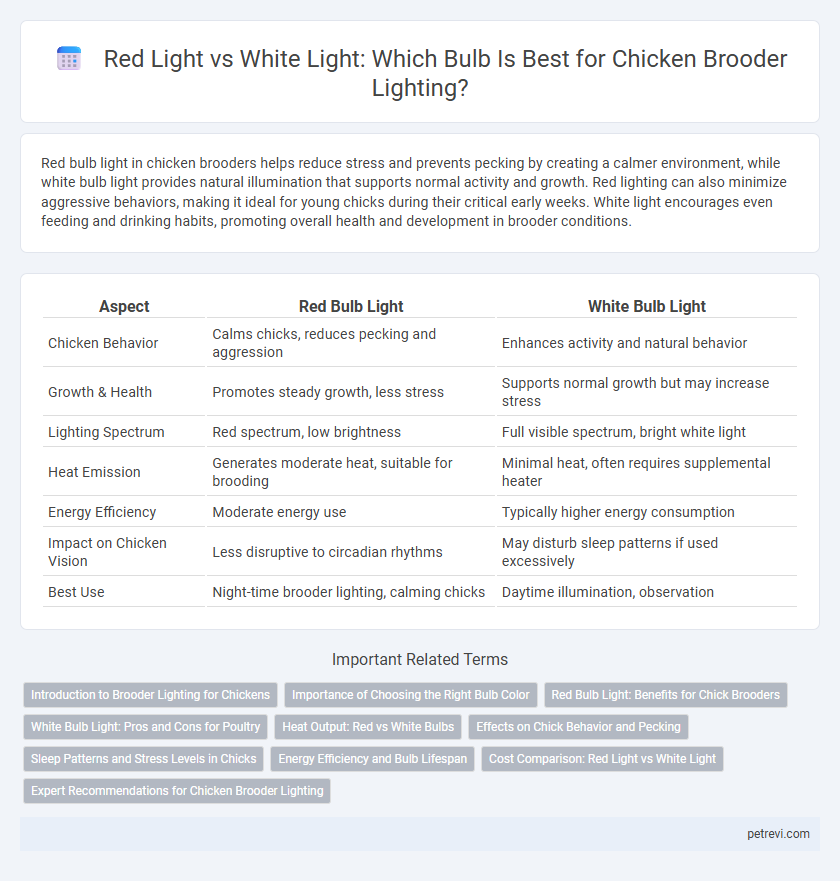Red bulb light in chicken brooders helps reduce stress and prevents pecking by creating a calmer environment, while white bulb light provides natural illumination that supports normal activity and growth. Red lighting can also minimize aggressive behaviors, making it ideal for young chicks during their critical early weeks. White light encourages even feeding and drinking habits, promoting overall health and development in brooder conditions.
Table of Comparison
| Aspect | Red Bulb Light | White Bulb Light |
|---|---|---|
| Chicken Behavior | Calms chicks, reduces pecking and aggression | Enhances activity and natural behavior |
| Growth & Health | Promotes steady growth, less stress | Supports normal growth but may increase stress |
| Lighting Spectrum | Red spectrum, low brightness | Full visible spectrum, bright white light |
| Heat Emission | Generates moderate heat, suitable for brooding | Minimal heat, often requires supplemental heater |
| Energy Efficiency | Moderate energy use | Typically higher energy consumption |
| Impact on Chicken Vision | Less disruptive to circadian rhythms | May disturb sleep patterns if used excessively |
| Best Use | Night-time brooder lighting, calming chicks | Daytime illumination, observation |
Introduction to Brooder Lighting for Chickens
Red bulb light in chicken brooders minimizes aggression and reduces pecking behavior, promoting a calm environment for chicks. White bulb light offers brighter illumination, enhancing visibility and helping in early chick development by mimicking natural daylight. Optimal brooder lighting balances warmth and visibility, supporting healthy growth and minimizing stress in young chickens.
Importance of Choosing the Right Bulb Color
Choosing the right bulb color for chicken brooder lighting significantly impacts chick health and behavior. Red bulb light reduces pecking aggression and stress, promoting calmer interactions, while white bulb light supports natural circadian rhythms and better visibility for monitoring. Optimal bulb selection balances chick comfort with growth efficiency, ensuring a healthy brooding environment.
Red Bulb Light: Benefits for Chick Brooders
Red bulb light in chicken brooders reduces stress and aggressive behavior among chicks by limiting visual stimuli, promoting calmer interactions. It helps maintain a stable circadian rhythm by minimizing disruption to melatonin production, essential for healthy growth and immune function. The warmer hue of red light also prevents chicks from pecking at each other, reducing injuries and mortality rates compared to white bulb lighting.
White Bulb Light: Pros and Cons for Poultry
White bulb light in chicken brooders provides bright, natural illumination that supports chicks' natural behavior and encourages even distribution of heat, reducing crowding and stress. However, this intense lighting can cause increased activity levels in poultry, potentially leading to aggression and higher energy consumption. Despite this, white bulbs facilitate easier monitoring of chick health and cleanliness, making them a practical choice for many poultry farmers.
Heat Output: Red vs White Bulbs
Red bulb lights produce lower heat output compared to white bulb lights, making them more suitable for maintaining consistent warmth in a chicken brooder without overheating. White bulbs emit higher heat, which can cause stress to chicks by raising the ambient temperature quickly and unevenly. Using red bulbs helps reduce aggressive behavior in chicks while providing sufficient heat for healthy growth.
Effects on Chick Behavior and Pecking
Red bulb light in chicken brooders reduces pecking aggression by minimizing visual stimulation, promoting calm behavior and lowering stress levels. White bulb light offers natural illumination that supports normal circadian rhythms but may increase bullying and feather pecking due to heightened visibility. Studies show red lighting can improve overall chick welfare by limiting injurious pecking and fostering a more peaceful environment.
Sleep Patterns and Stress Levels in Chicks
Red bulb light in chicken brooders promotes more natural sleep patterns by minimizing disruption to chicks' circadian rhythms, resulting in lower stress hormone levels compared to white bulb light. White bulb light emits a broader spectrum that can overstimulate chicks, increasing corticosterone production and leading to restlessness and elevated stress. Studies show red light reduces aggressive behavior and enhances growth rates, making it optimal for maintaining calm and healthy chicks during brooding.
Energy Efficiency and Bulb Lifespan
Red bulb lights in chicken brooders typically offer better energy efficiency by consuming less electricity compared to white bulb lights, which can lead to cost savings over time. The lifespan of red bulbs often surpasses that of white bulbs due to lower heat emission and reduced stress on internal components. Choosing red bulb light enhances overall brooder lighting efficiency while maintaining adequate warmth and comfort for chicks.
Cost Comparison: Red Light vs White Light
Red bulb lights generally cost more upfront, but they are energy-efficient and can reduce stress in chicks, potentially lowering overall brooding expenses. White bulb lights tend to be cheaper initially but consume more electricity and may increase the risk of aggression among chickens, potentially leading to higher veterinary costs. Evaluating long-term energy savings and animal welfare impacts is essential for an accurate cost comparison between red and white bulb lighting in chicken brooders.
Expert Recommendations for Chicken Brooder Lighting
Experts recommend red bulb lights for chicken brooder lighting because they reduce stress and prevent aggressive behaviors such as pecking, promoting healthier flock dynamics. Red light preserves the chickens' circadian rhythm by minimizing disruptions to their natural sleep patterns, aiding in better growth and development. White bulb lights are less favored as they can cause overstimulation and increased activity, potentially leading to slower growth rates and heightened stress levels among chicks.
Red Bulb Light vs White Bulb Light for Chicken Brooder Lighting Infographic

 petrevi.com
petrevi.com